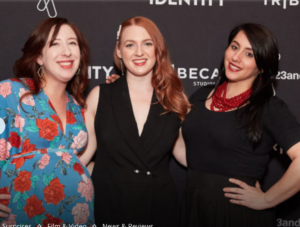
Amber van Moessner, Aubrey Smyth, and T.J. Raphael, Alison Luntz Photography
When Amber van Moessner was 29 years old, she was shocked to learn through taking a 23andMe DNA test that she’d been donor conceived and that the father she’d grown up with was not her biological father. To try to make sense of this bewildering and distressing news, she took a deep dive into the research on the subject. “I was doing a ton of reading and interviewing anyone I could talk to about this issue — doctors, medical historians, other donor conceived folks.”
At the same time, filmmaker Aubrey Smyth was casting about for subject for a new film. After her short film about surviving cancer, “The Bout,” won the grand prize at the Moët Moment Film Festival, Smyth was given tickets to the Tribeca Film Festival, where she learned that Tribeca Studios and DNA testing company 23andMe had partnered to make “Identity” — a series of short, impactful stories about journeys of personal discovery.
van Moessner mentioned her story and her research project to T. J. Raphael, a journalist and producer at Slate, who knew that Smyth was in search of a documentary subject that might be a good match for the Tribeca-23andMe project. After Raphael (a consultant on the film) connected the two women, van Moessner invited Smyth to her support group for donor conceived people, where Smyth was shocked to learn that some donor conceived people had inherited genetic disorders from their donors and had no legal ability to access information about their donors’ medical history. “Almost all of the support group members had been lied to by their parents about their conception,” recalls Smyth, who was inspired by the way van Moessner and the other group members were advocating for change at the state and federal level. “It made a big impression on me because the only stories I heard on the news were about the big, happy family reunions and how everyone looked alike — end of story. I wanted to give Amber the platform to reveal the realities of being a donor conceived person and raise awareness about the lack of regulation in the fertility industry,” she says.
The result of this serendipitous connection is “The Need to Know,” a powerful documentary film that premiered on Vimeo during the 2019 Tribeca Film Festival. Filmed in a total of 5 days in Brooklyn, Chicago, and Sacramento, the documentary, which took six months to complete, manages in a mere 11 minutes to express the range of complicated emotions experienced by donor conceived people and the messy web of issues arising from ethically dubious fertility industry practices.
In the film, van Moessner recalls her surprise when a DNA test reveals that she’s primarily Jewish, yet no one in her family is Jewish. In an emotional phone conversation, she confronts her parents, who acknowledge the truth, telling her they chose to believe it was her father’s sperm, not the donor’s, that resulted in her conception. “How do you think about who you are,” van Moessner asks, “when you don’t know who you are?” At 23 weeks pregnant and concerned about the health of her future child, van Moessner, along with her newfound half-sister, Kaitlin Thompson, begin to act on their need to know who their father is. What unfolds is a striking synopsis of the costs of donor anonymity. Smyth follows van Moessner to Chicago, where she meets Nick Isel and his attorney, Michelle J. Rozovics, to discuss Isel’s FDA Citizen Petition requesting an end to donor anonymity, increased duration of record retention, and record redundancy. As Smyth interviews several other donor conceived individuals, advocates, and an egg donor, their stories speak to the need for ethical oversight and regulation of an industry that’s almost entirely ungoverned. More than their words, van Moessner’s expressive face communicates the pain and frustration of finding herself in an untenable position over which she has no control.
Smyth, who at 21 created her own production company, Gingersnap NYC, has been a film and commercial director for nine years, with a background in narrative filmmaking and documentary-style branded content. “I was so moved by Amber’s story that I decided to direct my first documentary, and I wanted to tell Amber’s story with strong intention.” She describes the narrative techniques she used in the composition and framing to symbolize and accentuate the content of a scene and tell van Moessner’s story:
“In a scene in which Amber’s biological father tells her and her half-sister that they have 75 siblings, we frame only half of their faces and leave negative space between them. This is juxtaposed with an angle on the father, who is centered and fills the empty space. Later, the camera lingers outside his house on a charm of hummingbirds he cares for, symbolizing in an unforeseen way the 75 children he’s fathered. The group scene shows each person stationary and centered in the frame so the audience must concentrate on what they’re expressing. When Amber is interviewed, she’s placed against a black and white background to convey how this issue is not one-sided. The prisms and distorted faces at the end symbolize the donor conceived people who discover the truth and question their identity, many of whom told me they would stare into the mirror and not recognize the person looking back at them.”
“Documentary film,” Smyth says, “has the unique ability to change minds. ‘The Need to Know,’ she adds, “treats conflicting perspectives fairly, and we were able to reach people with emotion and logic. We cover the ethical and legislative issues that donor conceived people have with the business of creating people, and it was important for the film to uphold integrity. We relied on facts while simultaneously conveying very difficult emotions.”
It wasn’t easy for van Moessner to speak so candidly and publicly about something so new, shocking, and painful. “I think a lot of people wonder why I would share something so personal and really drag my family through that. But, ultimately, if I can stop one family from lying to their child, or make someone reconsider being, or using, an anonymous donor, it will all be worth it,” she says. “I don’t want anyone else to go through the pain I went through.” Because a lot of people in her family didn’t know her story, she describes the film as being a “bit of a coming out. I was able to rip off the Band-Aid of ‘telling’ without having to individually tell dozens of people. My parents were hesitant about being involved, but they were ultimately supportive as well.”
However difficult it was to tell her story, van Moessner believes it also proved to be healing. “It was a way to process my grief, confusion, anger, and frustration,” she says. “It made me feel like I could manage all of that if I could do something about it.” Doing something required increasing awareness, and she remembered well how little aware she had been about these issues until the subject hit home. “Before I found out I was donor conceived, sperm or egg donation was never something I thought twice about,” she says. “I had friends who’d considered being egg donors, and I knew sperm donation existed, but I had never thought about the implications or the industry behind it. And now that I’m telling my story, so many people have said to me, ‘I never thought about this!’ So I really wanted to raise a flag and say, ‘hey, have we as a society really thought this through?’” She points to a meme that turns up often in the donor conceived community — a quote from “Jurassic Park”: “Your scientists were so preoccupied with whether or not they could, they didn’t stop to think if they should.”
The response to the “The Need to Know” has been overwhelming and positive. Not only was the film viewed 2,000 times in two days, but van Moessner received an outpouring of positive response from individuals in the donor conceived community. One person told her they posted the film on social media as a way of coming out to friends about having been donor conceived. Smyth believes the facts presented in the film offer a compelling argument for the need to know about family medical history. “I hope the film proves why it’s important for donor conceived people to have access to their medical information and to know who their biological parents are and shows the actions donor conceived people are taking to change the system. The American Society for Reproductive Medicine, Smyth observes, has acknowledged that anonymity of sperm and egg donors is no longer sustainable due to the advent and popularity of genealogical DNA testing. “This conversation urgently needed to happen because the law has not kept up with modern technology.”
Smyth hopes to extend the conversation by developing a docuseries that looks at the ethics of donor conception and the fertility industry and examines pertinent legislation. “There are many sides to this topic, and I want to explore the variety of perspectives.”
And van Moessner, though encouraged by the reception and pleased and proud to have raised so many important issues, acknowledges that there’s more work to do. “The struggle with creating a short film is that there are so many issues we left on the cutting room floor. I want to talk about donor fraud. I want to talk about the complicated ethnic/race/class issues that abound in the donor conceived world. I want to talk about older donor conceived people who have fewer resources when they find out and discuss the implications of that. I want to talk about LGBT issues and how they fit into this conversation. There are so many layers to this issue — we really just scratched the surface, but I hope it’s enough to pique people’s interest and let them do their own investigating.”“The Need to Know” is one of 23 equally compelling films that all explore feelings arising from a DNA journey. The project began, says Tracy Keim, VP of brand and consumer marketing at 23andMe, when the company was invited to be a sponsor of the Tribeca Film Festival. 23andMe suggested something a little different — a more branded integrated sponsorship that would tap into Tribeca’s community of filmmakers for ideas about films concerning DNA stories. “They were excited,” Keim says, “because they’d never done anything like this and it was a cool challenge for the next level of cobranding and sponsorship.”
The project came together quickly. “We flew out last year to the Tribeca Film Festival and spoke to a group of filmmakers, took submissions, and looked at more than 50 treatments that were amazing.” They were looking for tension-filled stories with raw subjects that illustrate what’s at stake in these DNA journeys. They selected and commissioned 23 filmmakers — insisting that at least half be women — and set them loose with virtually no guidelines or restrictions except a requirement to show a rough cut and permit editing. “We were very light-handed,” Keim says. “We didn’t tell them how to make the films or what to do.”
Anticipating 3- to 5-minute films, 23andMe was surprised when many came in at closer to 13 minutes. “The filmmakers loved it because as they got into it they felt so passionate when they realized the humanity behind the science, so they wanted to do more.” To celebrate the launch of the films, the 23 filmmakers and their subjects were invited to the Tribeca Film Festival, and five of the female filmmakers took part in a panel moderated by filmmaker Dylan McGee, who runs Makers, a platform that aspires to assemble the largest collection of women’s stories.
What these extraordinary filmmakers captured are diverse stories of birthparents on quests to find the children they’ve longed for their whole lives, children looking for the parents they’ve never known, adoptees searching for siblings, NPEs (non-parental events or not parent expected) rocked by surprises, transracial adoptees exploring their lost cultures — all people reaching for the pieces of the puzzles of their lives, each seeking to understand how their past has influenced their present. These rich, captivating stories skate across issues of culture, ethnicity, race, human rights, shame, and truth. Each in its own way addresses how we make meaning of our histories and DNA connections and how we define or redefine ourselves.
Embracing knowledge of the past can be empowering, says Keim, whose aim is that the films serve as a platform that will embolden viewers and let them “look into their past to heal their pain, move forward, or discover something new that can lead to a more fulfilling life.” She hopes the films give viewers courage and help them realize they’re not alone.
View the trailer here and watch all the films on Vimeo. In addition, on YouTube you can view films about 23andMe customers created by documentarians from Transient Pictures, a NYC documentary production company. You can also watch customer-submitted stories — and submit your own — at the company’s Stories Page.
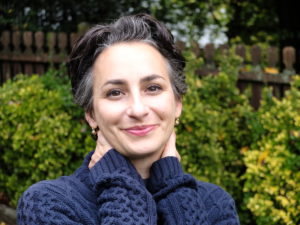
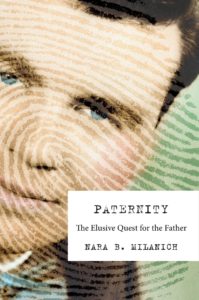
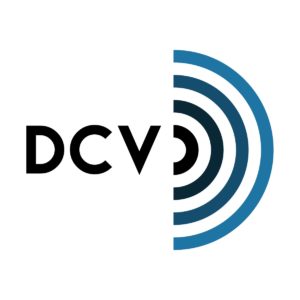 Complex feelings and experiences—like those associated with genetic identity—may be difficult to share through words alone. But art can get to the heart of the matter and communicate more compellingly the tangled emotions and nuances of experiences that arise from grappling with genetic identity issues. There are myriad benefits of artistic expression. Not surprisingly, art is widely known to be a therapeutic strategy, both healing the creators and engendering understanding and empathy in those exposed to it.
Complex feelings and experiences—like those associated with genetic identity—may be difficult to share through words alone. But art can get to the heart of the matter and communicate more compellingly the tangled emotions and nuances of experiences that arise from grappling with genetic identity issues. There are myriad benefits of artistic expression. Not surprisingly, art is widely known to be a therapeutic strategy, both healing the creators and engendering understanding and empathy in those exposed to it.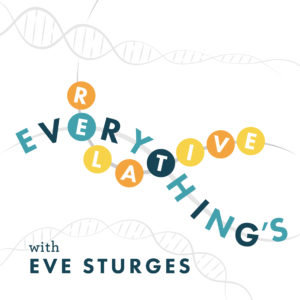 In her new podcast, Everything’s Relative, writer and therapist Eve Sturges talks with individuals whose lives have been upended by DNA surprises.
In her new podcast, Everything’s Relative, writer and therapist Eve Sturges talks with individuals whose lives have been upended by DNA surprises.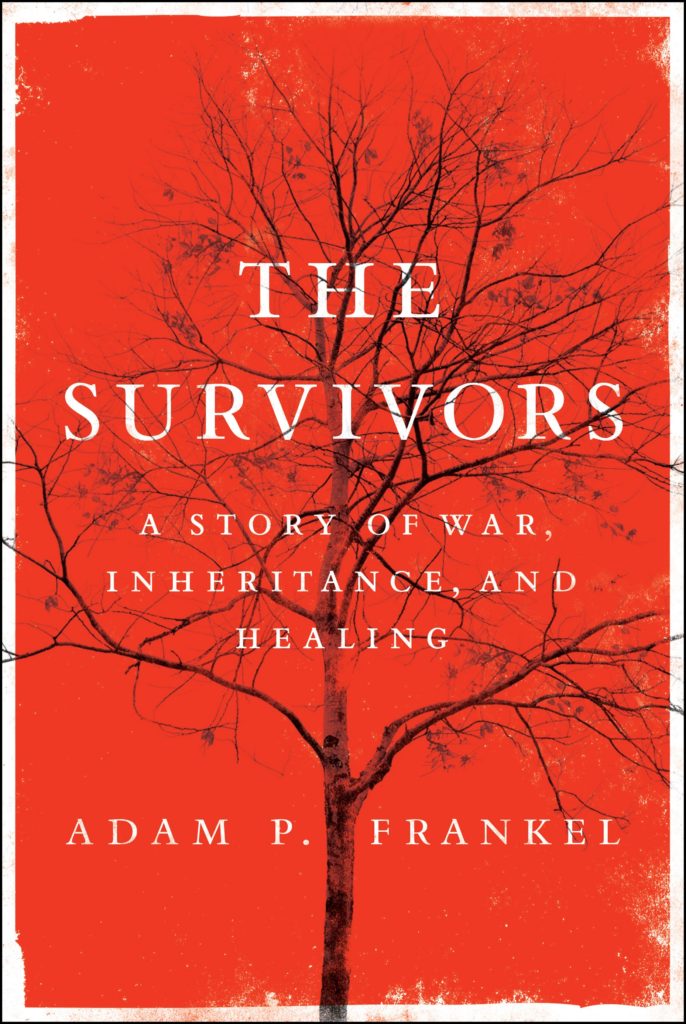 When he was only 25 years old and working as a speechwriter for Barack Obama, Adam Frankel learned a searing truth about himself—one his mother intended him to live his days without knowing.
When he was only 25 years old and working as a speechwriter for Barack Obama, Adam Frankel learned a searing truth about himself—one his mother intended him to live his days without knowing.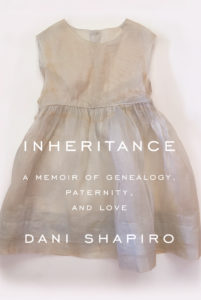 Author Dani Shapiro has explored family secrets from every angle in an exceptional decades-long writing career that until now yielded five novels and four memoirs. Revisiting those works, it’s tempting to believe everything she’s experienced and written has been prelude to her 10th book, the bestselling “
Author Dani Shapiro has explored family secrets from every angle in an exceptional decades-long writing career that until now yielded five novels and four memoirs. Revisiting those works, it’s tempting to believe everything she’s experienced and written has been prelude to her 10th book, the bestselling “